The Apple iPhone 6s and iPhone 6s Plus Review
by Ryan Smith & Joshua Ho on November 2, 2015 8:00 AM EST- Posted in
- Smartphones
- Apple
- Mobile
- SoCs
- iPhone 6s
- iPhone 6s Plus
Battery Life
With any smartphone, battery life is always one of the most important considerations. It probably goes without saying that more battery life is always better. In the case of the iPhone 6s, battery life is especially important to examine because this year Apple has actually made the battery of their phone smaller than before. Normally, it’s almost a given that battery size will be at least constant or increase but in order to accommodate additional components like the Taptic engine the battery has been made smaller. In light of this reversal one might assume that battery life has decreased as a result, but given the move to a FinFET process and other major component improvements it’s hard to say how battery life has increased or decreased. In order to test this properly, we ran the iPhone 6s’ through our suite of battery life tests to try and get an idea for overall battery life. As always, we run all battery life tests with the display set to an average of 200 nits and all possible background tasks disabled.
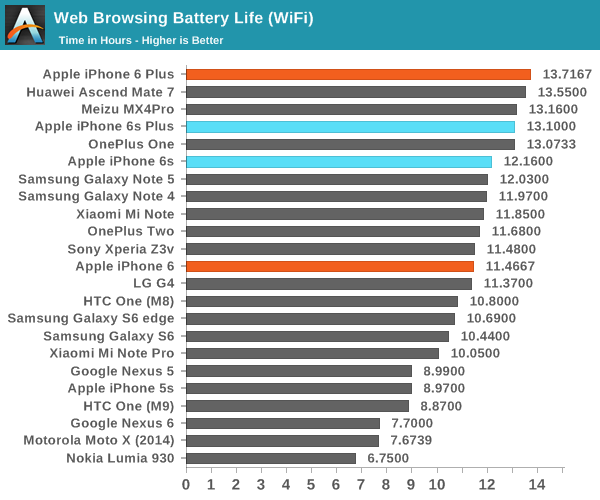
Our first test is WiFi web browsing, and here we see a pretty curious trend. The iPhone 6s Plus appears to regress relative to the iPhone 6 Plus, yet the iPhone 6s solidly beats the iPhone 6. I was pretty confused by this, but it’s likely that we’re seeing these results because the iPhone 6s is going to have larger relative power consumption of the SoC when compared to the display. As the display becomes bigger, the effects of SoC efficiency are just harder to notice, which also explains why it looks like the iPad Air 2 has effectively the same battery life whether you’re running just a blank display or our web browsing test. Both of our review units use a TSMC A9, so I don’t think we can attribute a foundry difference to the odd results that we’re seeing here.
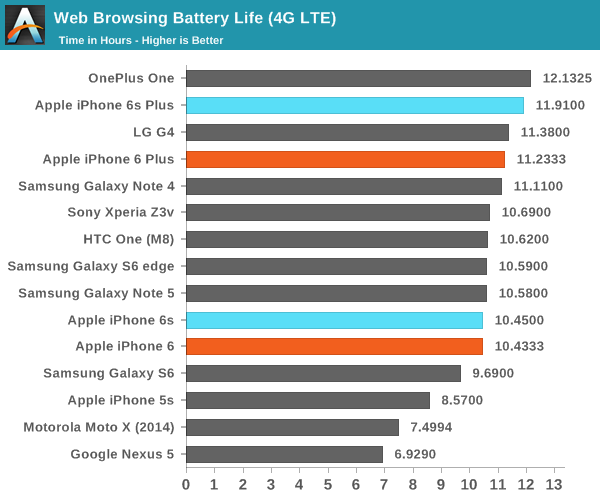
In LTE web browsing, we see a smaller improvement than what we observed in the WiFi test. This might seem strange, but given that the move from a 28nm process to a 20nm process on the modem from iPhone 6 to 6s didn’t come with FinFET it makes sense that the modem will remain a significant power drain. It’s likely that the next big jump in battery life here will come with FinFET process technology on the modem, along with other general modem design improvements.
In order to also look at battery life in more extreme scenarios, we use Basemark OS II and GFXBench to really place a strong stress on the CPU and GPU to see what power draw is like under sustained load. This also allows us to see the extent to which various components of the phone throttle down in response to relatively high sustained loads. However, it’s important to note that the Basemark OS II performance score here isn’t necessarily as accurate as scores from Android devices as the battery score can be calculated with 98 data points instead of 80 as battery score is partially derived from the rate at which the battery percentage decreases. It's also worth noting that in GFXBench there are two data points removed as the low power popup causes an incorrect frame rate to be recorded.
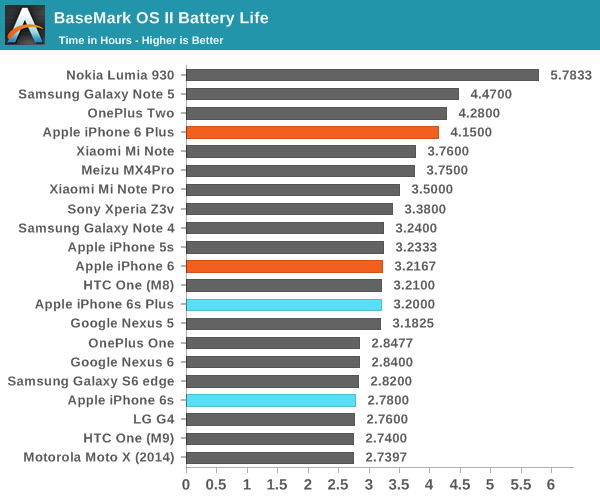

In Basemark OS II, we start off with a pretty shocking result as the iPhone 6s lasts less than three hours in this test, but looking at the battery score it’s pretty clear that the reason why the iPhone 6s doesn't last very long is because it’s running with relatively little throttling throughout the test, so the battery score is high as a result. The same is true of the iPhone 6s Plus, but the larger battery helps it to last a bit longer.
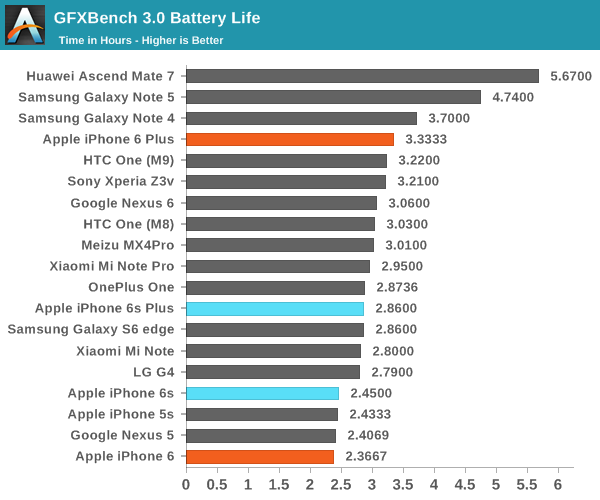
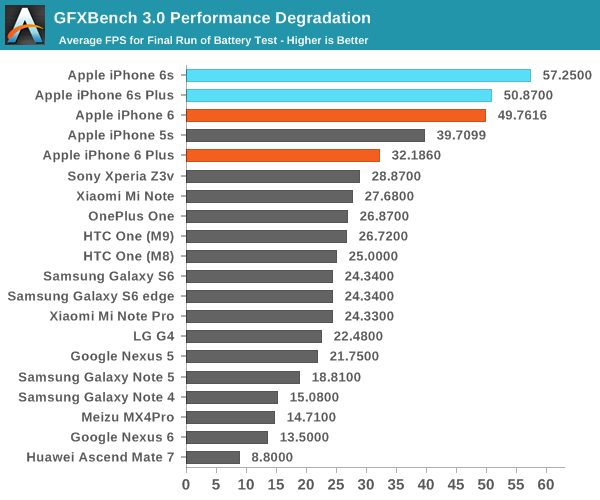
Looking at GFXBench, which is an infinite loop of the T-Rex on-screen benchmark to approximate intensive video gaming we see that the iPhone 6s doesn’t last very long either, but the performance throughout the test is incredible. Due to 1334x750 display resolution and strong GPU, the iPhone 6s manages to last the entire test without any notable throttling, and effectively pegged at the refresh rate of the display. The iPhone 6s Plus manages a similar level of performance but over time you can start to see some throttling, likely a function of the longer runtime and higher display resolution. It’s interesting to see how in the space of two years just how much progress has been made here in terms of improving GPU performance and efficiency, as when we first ran this test it was probably one of the most stressful tests out there for any smartphone or tablet.
Charge Time
Of course, while battery life is usually the main determinant of overall mobility it’s often important to consider charge time. A phone that charges slowly can be much less mobile than another phone, even if it has better battery life. In the case of the iPhone 6s’, it seems that Apple continues to ship the standard 5W charger that they have for many generations in the smartphone industry. In order to see how this charger and phone combination performs, we use our usual methods of timing the phone from fully discharged to fully charged.
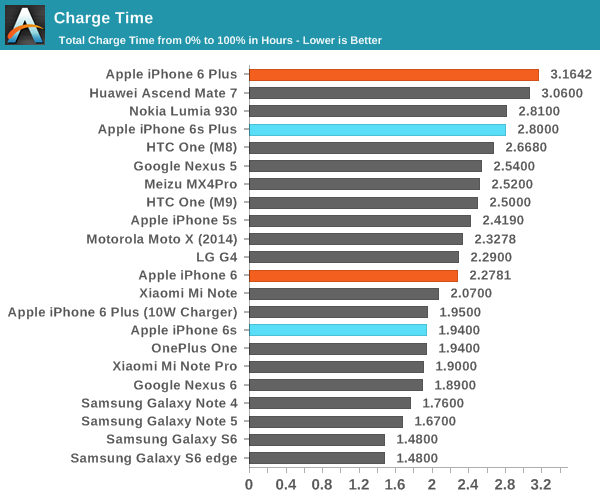
Here, the iPhone 6s and 6s Plus both show a decent improvement over the iPhone 6 and 6 Plus, but not enough to make an significant difference. The iPhone 6s charges at a pretty reasonable rate, but the iPhone 6s Plus really does need a more powerful charger than it does now. You can use an iPad charger to bring things back up to speed but getting this means that you either have to have an iPad already or you have to go out and buy an iPad charger, which is on the annoying side when Android OEMs generally include fast chargers in the box.


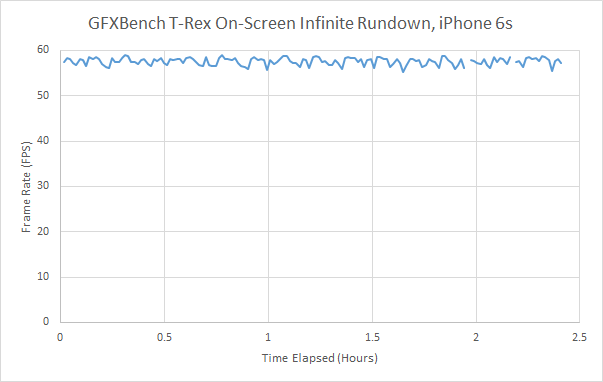
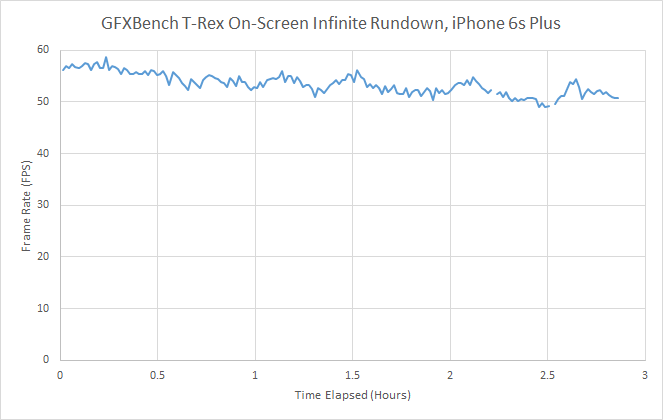
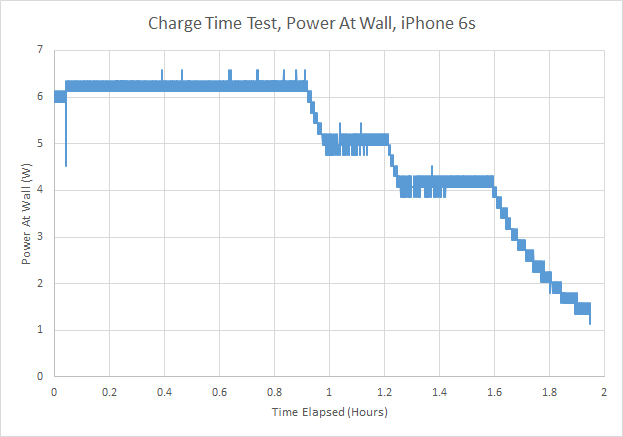
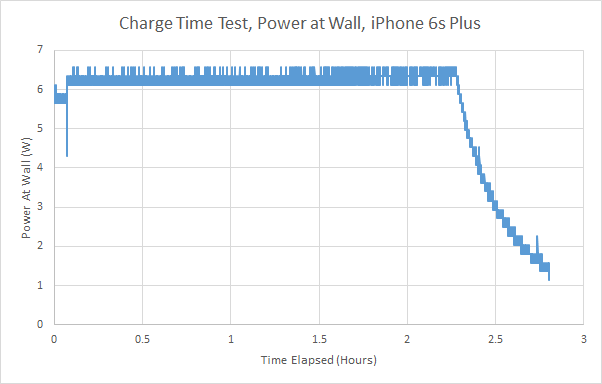








531 Comments
View All Comments
Der2 - Monday, November 2, 2015 - link
Its about time.zeeBomb - Monday, November 2, 2015 - link
Oh man...oh man it's finally here. I just wanted to say thank you for faithfuflly using all your findings to incorporate this review. It may have take a little longer than expected, but hey, this is my first anandtech review that I probably camped out for it to drop, lol...thanks again Joshua and Brandon!zeeBomb - Monday, November 2, 2015 - link
Ugh. I meant Ryan Smith...sorry! Waking up at 5 isn't the ideal way to go...Samus - Thursday, November 5, 2015 - link
That's what she said, Der bra.zeeBomb - Sunday, November 8, 2015 - link
Very valid point. Speaking of valid points... 500!trivor - Thursday, November 5, 2015 - link
Have to disagree with your statement that the high end Android phone space has stood still. With this round of phones the Android OEMs have all upped their game to approximate parity with the iPhones and in some cases exceed the performance and quality of images taken by an iPhone. In addition, on phones like the LG G4 the option of having manual control of your picture taking and supporting RAW/JPEG simultaneously is a huge advance for smartphones. Add to that, phase change focusing, laser rangefinder for close focus, generous internal storage (32 GB) and micro SD expansion (which works quite well on Lollipop - not sure about Marshmallow yet) you have a great camera phone. It also has OIS 2.0 (whatever that means) at a significantly lower cost than even the low end (16 GB) iPhone 6s @ $450-500 for the G4 versus $650 for the iPhone. While iOS seems to get apps updated a little quicker, look nicer from what I've heard and seem to be a little more feature rich. Conversely, the Material Design language has greatly improved the state of Android interfaces to give Android OEMs a much more stable OS - although the first builds of Lollipop were not ready for prime time. Also, let's not forget that Android dominates the low - middle range of Smartphones below $400 with near flagship specs, excellent cameras in phones like the Motorola Style (Pure Edition in the US), Motorola Play (is apparently the base model for the Droid Maxx 2 for Verizon, a number of the Asus Zenphones, the Moto G and E. Also, the new Nexus' (6P and 5X) are both competitive across the board with new cameras with 1.55 micron pixels that let in significantly more light than the 1.12 pixels in other cameras, are competitively priced (especially the 6P @ $499), and are overall very nice handsets. Finally, the customizability and wide variety of handsets at EVERY PRICE POINT make Android a compelling choice for many consumers.Fidelator - Friday, November 6, 2015 - link
I couldn't agree more, the Android space has not stayed still, if anything, most of the problems on that side were due to Qualcomm's lack of a good offering this year, still, the phones were further refines in other areas, saying this is overall the best camera phone given the only advantage it has over the competition is reduced motion blur is complete bull, the UI is far from the best given that auto on both the SGS6/Note 5 and the G4 is as effective yet those still offer great manual settings.The -barely over 720p- display on the 6S is inexcusable for 2015 and given the starting price of the 6S should not be passed as an acceptable not even as a good display.
Where Apple deserves credit is with the A9, it is miles ahead of anything the competition currently offers, they have made some fantastic design choices, it just is on the next level.
robertthekillertire - Monday, November 9, 2015 - link
I'm actually very happy with Apple's decision to stick with a lower-resolution screen. Which would you rather: a smartphone with an insanely high pixel count that your eyes probably can't appreciate anyway, or a smartphone with a lower PPI (but barely perceptibly so) that gets better battery life and has smoother UI and game performance because it's not trying to push an absurd number of pixels at any given moment? The tradeoff just doesn't seem worth it to me.MathieuLF - Tuesday, November 10, 2015 - link
But your eyes can tell the difference... When I had my iPhone 6+ and Nexus 6P side by side I can see it right away that the Nexus has more pixelsCantona7 - Tuesday, December 1, 2015 - link
But the difference is not large enough to justify heavier power consumption and greater graphics requirement. I agree that more pixels is certainly more pleasant to the eyes, but I'd rather greater battery life. If the Nexus 6P had a lower resolution screen, it would have a even greater battery life which would be awesome